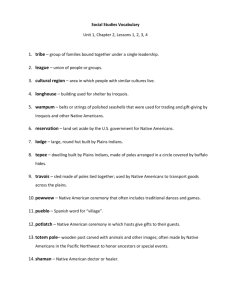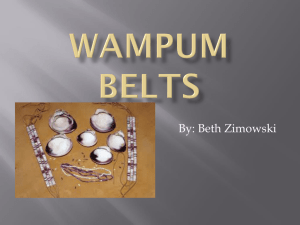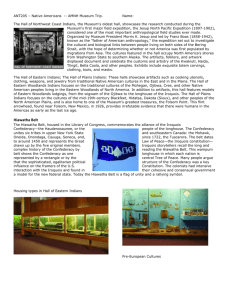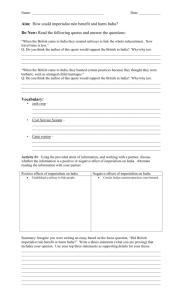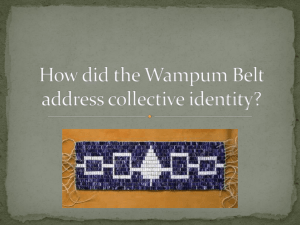Native American History and Culture
advertisement
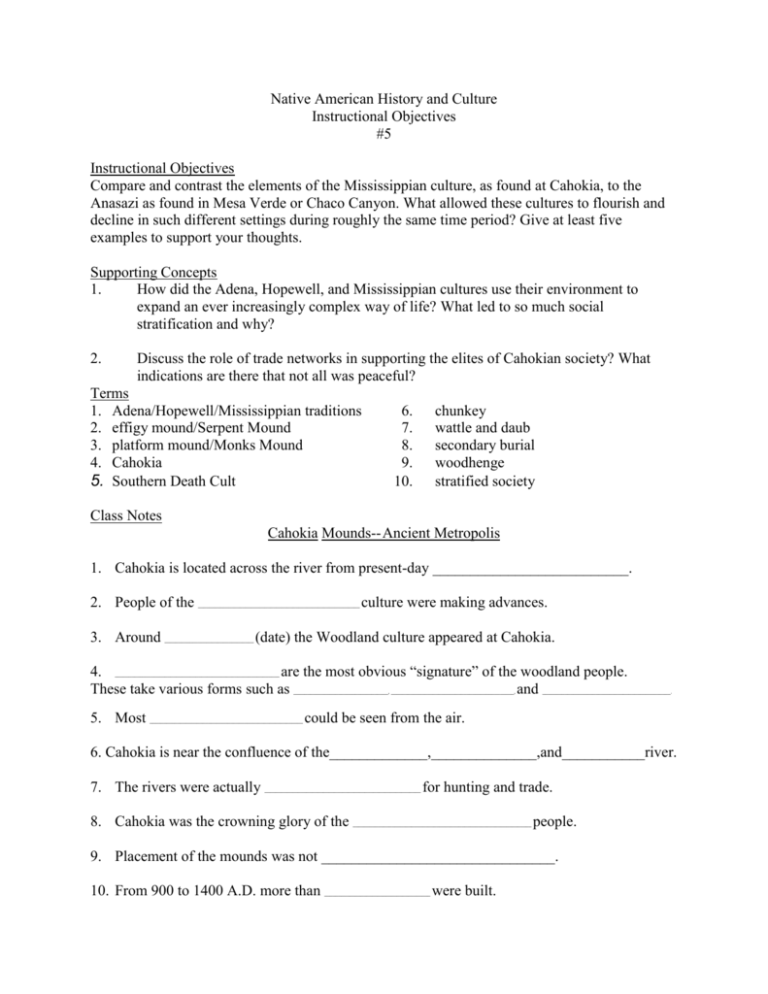
Native American History and Culture Instructional Objectives #5 Instructional Objectives Compare and contrast the elements of the Mississippian culture, as found at Cahokia, to the Anasazi as found in Mesa Verde or Chaco Canyon. What allowed these cultures to flourish and decline in such different settings during roughly the same time period? Give at least five examples to support your thoughts. Supporting Concepts 1. How did the Adena, Hopewell, and Mississippian cultures use their environment to expand an ever increasingly complex way of life? What led to so much social stratification and why? 2. Discuss the role of trade networks in supporting the elites of Cahokian society? What indications are there that not all was peaceful? Terms 1. Adena/Hopewell/Mississippian traditions 2. effigy mound/Serpent Mound 3. platform mound/Monks Mound 4. Cahokia 5. Southern Death Cult 6. 7. 8. 9. 10. chunkey wattle and daub secondary burial woodhenge stratified society Class Notes Cahokia Mounds-- Ancient Metropolis 1. Cahokia is located across the river from present-day __________________________. 2. People of the 3. Around __________________________________________________________ ________________________________ culture were making advances. (date) the Woodland culture appeared at Cahokia. 4. are the most obvious “signature” of the woodland people. These take various forms such as and ___________________________________________________________ __________________________________, ____________________________________________, 5. Most _______________________________________________________ ______________________________________________. could be seen from the air. 6. Cahokia is near the confluence of the_____________,______________,and___________river. 7. The rivers were actually ________________________________________________________ 8. Cahokia was the crowning glory of the for hunting and trade. ________________________________________________________________ people. 9. Placement of the mounds was not _______________________________. 10. From 900 to 1400 A.D. more than ______________________________________ were built. 11. The three types of mounds are________________________, ________________________, and __________________________. 12. Structures were erected on _________________________________________. 13. Monks Mound is hemisphere. It covers 14. ______________________________________ ________________________ stories high and is the largest earthen structure in the western acres. ___________________-_________ cubic feet of dirt were moved to build this mound. 15. Cahokia‟ s engineers used different types of _________________________________ to aid ______________________. 16. Many mounds have been lost to the _______________________________________ and the _____________________________________________. 17. The most common buildings at Cahokia were the ________________________________. 18. The astronomical “woodhenge” served as a _______________________________ that tracked the movement of ___________________________________________________. 19. Surrounding the heart of the metropolis was a two mile __________________________. 20. Each required ______________________________________________________ 21. Plazas were “lined” with to complete it. _____________________________________________________________________ trampled to concrete. 22. In 1150, with an estimated population of_______________ (number), Cahokia was the largest city in North America. 23. It had suburbs, main city. ___________________________________________________ and _____________________________________________________ that helped support the 24. There is no doubt that Cahokia was a ________________________________. 25. ________________________________ was the key to it all. 26. Enormous populations and large crops led to __________________________________________________________________________________________. 27. The chief was associated with the ________________________________ god. 28. Status, gender, age, and kinship all determined ______________________________________________________________________________. 29. _____________________________ provide the one chance we have to get into the minds of prehistoric peoples. 30. 31. __________________________________ used it to manipulate the lower classes. _________________________________________________________________________________________________ is the main theme of most symbols. 32. Some of the things found in Mound 72 are: a. ___________________________________________________________________. b.___________________________________________________________________. c. ___________________________________________________________________. 33. Dancing was probably ____________________________________________________. 34. The premiere sport at Cahokia was _____________________________________. 35. Tattooing enhanced beauty and indicated ________________________________________. 36. Seashells came from _____________________________________________________________ and _______________________________________________________________. 37. Copper was most often used for __________________________________________. 38. Quartz came from as far away as ________________________________. 39. There is no evidence of direct contact with _______________________________________________________________________________ 40. _______________________________ served as an abrasive. 41. ________________________________________________________________________________________ 42. Each house required ___________________________________________ was the tool that changed their lives. (number) trees. 43. The most important animal was the _______________________________. 44. The inner bark of the ____________________________________________________________________ 45. The decline of Cahokia began in was used for baskets. ______________________________________________________ (date). 46. The main reason for this occurrence was ______________________________. 47. Because 48. By _________________________________________________________ _________________________________________________ 49. To this day only was so successful, Cahokia failed. (date) it was all over. _________________________________________ percent of Cahokia has been excavated. cultures. Native American History and Culture Instructional Objectives #6 Instructional Objectives 1. Discuss the pre-contact lifestyle of the coastal Algonkian and show how their culture changed during the various phases of white settlement. What do you consider the most destructive elements of white contact and why? Give five specific examples to support your view. 2. Explain how Mi‟kmaq political and religious beliefs complimented their dispersed lifestyle. How does the giving and receiving of presents expand instructional practices? Give five examples to support your view. Supporting Concepts 1. If culture is based on a fabric of beliefs and values, what were the underlying social, economic, and political principles of Algonkian society? How do these compare with European/American values? 2. Explain the role of technology as an agent of change--be it good or bad-- amongst the coastal Algonkians. Terms 1. disease frontier 2. girdling/controlled burns 3. confederacies 4. wampum 5. matricentrism 6. sumptuary laws 7. 8. 9. 10. 11. 12. usufruct rights Pequot War (1637)/King Philips War (1675) John Eliot/praying Indians Samson Occom/Dartmouth College Stockbridge Indians mestizo faction Class Notes I. Pre-contact aboriginal culture A. Three ecological areas- coast, tidewater, mountain/interior 1. a. b. c. 2. a. b. c. d. 3. B. 1. 2. C. II. Settler phase (1620-1700) -displacement of tribes A. B. 1. 2. 3. 4. 5. 6. C. III. A. 1. 2. 3. 4. B. C. D. E. IV. Nonvanishing (1800-- ) A. B. C. 1. 2. Native American History and Culture Instructional Objectives #7 Instructional Objectives After viewing Invasion of the Coast and doing your reading, explain how English settlers used the coastal Indians‟ culture to the white traders‟ and settlers‟ advantage. Provide five examples of cultural practices exploited by the immigrating whites. Supporting Concepts 1. Discuss the wars in Virginia and Massachusetts as case studies of cultural conflict. 2. What internal mechanisms within Indian culture allowed for adaptation to the shifting circumstances. Terms 1. hominy 2. roach/scalplock 3. slash and burn agriculture 4. wigwam 5. confederacy 6. 7. 8. 9. 10. sagamore/sachem Powhatan Confederacy Pocahontas/John Smith Tisquantum/Massasoit Great Swamp Massacre Class Notes Invasion of the Coast 1. The East coast was home to over _____________ (number) tribes of Native Americans. 2. Thirty small nations united by 1600 into the ____________________________________. 3. In 1607, an English ship brought ___________________________________ (leader). 4. The colonists started to take ____________________________________ by force. 5. Smith was saved by __________________________ according to his memoirs written seventeen years later. 6. The chief Wahunsonacock, refused to __________________________________________. 7. The true balance of power was seen through the __________________________ between the nations. 8. _______________________________ was kidnaped for all of the English prisoners of war. 9. The American practice of__________________________ was taking hold in England. 10. By _______________ (date), the struggle was becoming useless. 11. Tisquantum, in 1619, came back to his home to find __________________________. 12. Five years earlier he had left as a _________________________--___________. 13. In 1620, the ______________________ sailed into a bay and started the ____________________________ colony. 14. Only ______________ of the colonists survived. 15. All of the Indians at Pawtuxet had died from ________________________. 16. Massasoit had a reason to seek allies because ______________________________________ _____________________________________________________________________________. 17. In the fall _________________ (number) acres of corn stood at the colony. 18. The first Thanksgiving took place in _____________________ (year). 19. Massasoit kept peace for __________________ years until leadership passed to his son _______________________________________. 20. The Indians were not only losing land and liberty but also their ______________________. 21. Newly established _____________________ were places Indians were encouraged to settle. 22. In Plymouth, Indians were shot for not __________________________________________. 23. The war was over not only loss of land but also __________________________________. 24. The ___________________________ massacre occurred when 300 Indians were killed. 25. King Philip‟s wife and son were _______________________________________. 26. He was shot through the heart and his head was ________________________________. 27. The number of towns destroyed was __________________ with ________________ (number) bushels of corn. 28. Joseph Brant said he felt like he and his people were between two hells -___________________________________ and ___________________________________. 29. ____________________________________ sold off land they did not even own. 30. Brant and his Mohawks were given refuge in _________________________________. 31. The ________________________, ironically, fared the worst at the hands of the Americans. 32. In 1990, a dispute erupted over _______________________________________________ ________________________________________________________________________. Native American History and Culture Instructional Objectives #8 Instructional Objectives Explain how Iroquois political organization reflects important values found in their religious and social organization. Give five examples that show how the Confederacy is tangible evidence of these beliefs put into practice. Supporting Concepts 1. Discuss the role of duality in social and political organization. How does this produce codependent bonds in various aspects of the society? 2. What role does mythology play in outlining the political organization and operation of the league? What metaphorical terms are used to describe the role of the Confederacy? Terms 1. League of the Longhouse/Iroquois Trail 2. three sisters/C-B-S 3. Fort Orange 4. clan mothers 5. factionalism 6. Keepers of the Eastern/Western Door 7. matrineal descent 8. clan/moiety 9. reciprocity 10.“antlers” of office Class Notes I. Iroquois -- New York to Pennsylvania, South of Great Lakes A. C-B-S. hunting and gathering B. 1. 2. 3. 4. 5. 6. Native American History and Culture Instructional Objectives #9 Instructional Objectives After viewing Divided We Fall and reading your text, discuss the major phases of Iroquois history as a time of organization, trauma, and reorganization between 1500 and 1900 A.D. What role did the Confederacy play in helping and hurting the Iroquois? Give five examples to support your views. Supporting Concepts 1. How did the Dutch, English and French play upon the underlying philosophy of the Iroquois Confederacy to achieve their own ends? 2. What economic and political pressures influenced the Iroquois to become embroiled in other people‟s conflicts? Terms 1. Five (Six) Nations 2. Deganawidah/Hiawatha 3. longhouse 4. Tree of Peace/Great Peace 5. Pine Tree Chiefs 6. keepers of the faith 7. 8. 9. 10. 11. 12. false face society orenda William Johnson/Joseph Brant Battle of Oriskany General John Sullivan Handsome Lake‟s Code Class Notes Divided We Fall 1. “Ho-de‟-no-sau-nee” means __________________________________________________. 2. The Iroquois called George Washington _______________________________________. 3. Salvation to the Iroquois came in the form of a man named __________________________. 4. The Five Nations of the Iroquois Confederacy were ___________________________, _______________________________, ________________________________________, _______________________________________ and _______________________________. 5. In July 1609, the Mohawks fought the French leader ______________________________. 6. The French relied on their _________________________ allies to obtain_______________ ________________________________________________________________. 7. The Iroquois got guns from the _____________________________________. 8. _________________________________ missionaries try to convert the Indians. 9. Diseases were believed to be part of______________________________________. 10. By __________________ (date), the Huron were wiped out. 11. The ___________________________________ was stained with blood. 12. The British renamed Dutch territory __________________________________. 13. The __________________________ chain was the name given to alliances. 14. In 1710, Iroquois ambassadors went to _________________________________________. 15. The ____________________________joined the confederacy. 16. The white man‟s coming was like a _________________________________ over the land. 17. In 1758, ________________________ began to live among the Seneca. 18. ____________________________ was the British Commissioner of Indian Affairs who married Molly Brant, an Iroquois. 19. The Iroquois cede lands in ____________________________ and_____________________ to the British government with an understanding that there would be no more expansion. 20. _________________________ and ______________________ were influenced by Samuel Kirkland to be on the American side. 21. ___________________________ encouraged the Mohawk and Seneca tribes to side with the British. 22. At the Battle of Senecas -- brother fighting against brother. , Oneidas fought the Mohawks and 23. More than _________ (number) lie dead. 24. Joseph Brant led a campaign against the ___________________________ people. 25. Chief Shenandoah fed _________________________ during the winter at ______________. 26. The _________________________ nation was attacked by General ____________ from New Hampshire. Native American History and Culture Instructional Objectives #10 Instructional Objectives 1. The Natchez illustrate a complexity in society that is not often found in North American Indian cultures. Explain the integration within social, political, and religious organization as expressed through the practices of this stratified society. Provide five examples to illustrate your thoughts. 2. Compare and contrast Natchez society, as discussed in class, and the Choctaw culture in your readings. As inhabitants in the same area at different times, these Indian cultures were different. What caused these differences and similarities? Was it ecological, social, technological, etc.? Supporting Concepts 1. Sumptuary laws and ranked society are obvious indicators of stratification and division of power. Give examples of this from Natchez society. 2. Why do rituals of rebellion strengthen a society‟s beliefs? How did this express both political and religious ideals? Terms 1. Great Sun/Great War Chief 2. White Woman 3. Suns, Nobles, Honored People Stinkards 4. ritual of rebellion 5. first fruits ceremony 6. 7. 8. 9. 10. red plume/white plume busk/eternal fire black drink chiefdom Green Corn Dance Class Notes I. The Natchez -- chiefdom -- bottom lands of Mississippi A. People (4,000 at contact around 1700) 1. a. b. 2. a. b. B. 1. 2. 3. 4. C. 1. a. b. c. 1. 2. 2. II. The league -- conceptualized as a matrilineal society A. B. C. 1. 2. 3. 4. 5. a. b. c. d. e. D. 1. 2. III. Handsome Lake (Seneca) Code (1799) A. B. C. D. AN OLD INDIAN CUSTOM: GIVING AND RECEIVING PRESENTS From: Wilbur K Jacobs, Wilderness Politics and Indian Gifts (Lincoln: University of Nebraska Press, 1967): 11-28. Today, those Indians living along the Eastern coast of North America are but a shadow in the history of the westward movement. Manuscripts and printed sources, however, have kept fresh the story of diplomacy, wars, and conflicts with the Europeans. Once again the sachems deliberate while the business of politics and presents unfolds. (Contemporary records refer to these gifts as presents.) Prestige was all-important in native diplomacy as denoted by the use of wampum and other gifts. Hospitality and loyalty traveled hand in hand with cunning and stratagem. Edmond Atkin, superintendent of Indian Affairs for the Southern Department, once said that no people understood and pursued theft national interest better than the Indians. This factor is well exemplified in the numerous lists of expensive gifts that the Indians received. The old Indian custom of giving and receiving presents proved to be a decisive factor in the story of Indian diplomacy along the Ohio and Northwest frontiers during the years 17481763. The French and the English found that in order to carry on diplomatic relations with the aborigines all conferences had to follow adherence to custom with painstaking regularity, especially with regard to the delivering of presents. Among the Iroquois, Algonquian, Muskhogean, and other linguistic families living along the Eastern seaboard, presents connoted “words.” In the metaphorical language of the forest, each gift might signify a wish or a greeting. Several gifts might denote special emphasis of one kind or another. For example, one gift might offer a prayer that the price of trading good be reduced. Another might figuratively „light” a warm council fire; still a third might signify that all could speak freely. The Jesuit fathers observed that presents spoke more clearly than the lips. From these illustrations, it is evident that the ambassador of the forest had to be well-stocked with suitable presents before he could make his wishes known in a public meeting. The freedom derived from what was essentially a democratic government, plus the fact that each warrior had to provide for himself, promoted individualism. A spirit of independence prevailed. The father‟s authority over his son was limited, while the sachem had difficulty in restraining his warriors. If the sachems had authority over their fighting men, it was for the most part due to the liberal presents that the native leaders bestowed. To be a sachem presupposed the individual to be a wealthy man. Gifts induced the warriors to pay respect to their leaders. One early account states that the tribesmen always inclined to those who gave them the most and those who flattered them the most. Rank, authority, and prestige were important. The exchange of suitable gifts among headmen during council meetings followed precedence of rank with painstaking adherence to custom. Privately bestowed gifts and those made in public meetings often stripped influential leaders of almost all their earthly possessions. As a matter of fact, generosity was much admired among the Indians. The successful hunter usually made a point of advertising his skill and his virtues of generosity by giving away part of his meat. Presents were used in government, in law-as “law” was understood among the aborigines-and in almost every kind of personal relationship. Generally speaking, these gifts served as a measure of compensation. If a murder was committed, lawful revenge could be taken on the murderer unless compensation was made. If this was not done, relatives could kill the guilty party without trial In the same light, a knife and some tobacco would “heal” a warrior who had been physically injured. These atonement offerings were quite expensive in the case of murder. By way of example, the Sauks and Foxes gave horses and silverwork. If a murder was committed outside the tribe, there was a possibility of war unless compensation was made. Indeed, if the eye-for-eye justice was not administered, the whole tribe had to contribute to the atonement presentation in order to keep the peace. Relations between tribes and confederacies were often governed by presents. They were used for peace, for reward, for requests, for declaring war, as a tribute, as a mark of distinction, as a bribe, for thanks, and as a token of friendship. With periodic inconsistencies in the legend of the chain of friendship as it concerned the Six Nations and the British, the story is repeated at many treaties. From numerous accounts, the gist of the story follows. Many moons ago, when the English first came to Albany, the Indians and their white brethren became friends. The Six Nations came to love their brethren, the English, so much that they tied their ship to a bush so that it would not float away. Perceiving that the bush would not hold the ship, the Indians then tied the ship to a great tree with a strong rope. As many moons passed, the sachems felt the rope might rot. As they wished to make their friends more secure, the Indians chained the ship to the distant mountains. The chain was of silver to present what was to be everlasting friendship. The significance of this remarkable chain was that it needed to be brightened or polished periodically with gifts. Thus, thousands of pounds were spent annually during the eighteenth century by the colonies. Especially did the Quaker colony drain the provincial treasury to “brighten the chain of friendship.” The implication was that each so-called “brightening” strengthened an alliance. Likewise, previous treaties were confirmed by investments in goods. Articles were commonly exchanged by both parties in a gesture of friendship. This usage was most evident at peace treaties. In diplomatic circles, wampum was important for two reasons. It was a common medium of exchange, and it had certain mystic qualities never fully understood by Europeans. Beads, often called grains, had a definite value in terms of beaver pelts, deerskins, or even English coin. White wampum was worked out of the inside of the conch shell, a large spiral univalve marine shell. The dark wampum, usually purple or blue inclining to black, was taken from the quahog, or quahaug, a thick-shelled American clam. Since no record has been found for the source of black wampum, it was probably erroneously called black because of its resemblance to dark purple. The size of the grains varied. Grains of the “Penn Wampum Belts” were approximately one-fourth of an inch wide and three-eighths to one-half inch in depth. According to X-ray reproductions, the perforations were between one-eighth and one-sixteenth of an inch in diameter. The grains were laced together with deerskin, cut into narrow strips. When laced, the grains were made into necklaces, bracelets, strings, belts, girdles, and collars. Each grain had its known value, the black or purple being worth twice to three times as much as the white. Since the grains had to be fashioned near the seashore, inland tribes traveled as many as six hundred miles to trade skins and pelts for this precious commodity. Wampum was popular enough to be carried as far west as the Dakota Indians. It would appear that the Atlantic seaboard Indians‟ possession of these raw materials for making primitive currency should have been a boon to them. Powerful inland confederacies, however, sometimes exacted backbreaking tribute from them in the form of wampum. In diplomatic circles, wampum was used in various ways. Collars and girdles were often employed, but strings and belts were more common. A string consisted of a group of leather strips (called strands) which were about three feet in length and tied together at one end. These were strung with grains of various colors. These colors were superimposed upon the white and purple grains to signify war, peace, friendship, or whatever the occasion demanded. Red was most popular, being painted over grains in both strings and belts. The strings were used for minor occasions; the belts, for major. The greater the size of the belt or string the more valuable it was and the more emphatic it made any speech that accompanied the wampum. In each case, the string and the belt served as a “word” or even a complete statement. In the construction of belts, the design was based on the pattern of leather strips which ran horizontally and vertically. Particular events warranted the construction of large belts, some six feet in length. Sir William Johnson‟s accounts of Indian expenses show that he bought wampum in large allotments of 3,000 grains and over. The grains were ordered with leather and thread, the latter being easier to use as lacing for the grains. Conrad Weiser‟s accounts list 2,000 grains in one bell; but the average belts used by the interpreter contained about 900 grains. Weiser‟s large belts were entirely of black grains, while his smaller bells were either all white or contained a few black grains. His strings ranged from 185 to 600 grains, and were either all white or contained some black grains. Roger Williams, an early authority, noted that the making of wampum beads was difficult. For one thing, before the natives received awls from Europe, they had to bore the shell currency with sharp stones. The English, observing the value placed on beads, made imitation porcelain beads which were sold to the Indians at what was probably a handsome profit. Designs on belts carried a special meaning. Conrad Weiser, in a meeting in 1748 with the Wyandots, described a very interesting pattern. Here the Indians showed Pennsylvania‟s interpreter a belt 25 grains wide and 265 grains long, in all containing almost 7,000 grains. In the design were seven Indians holding each other by the hand. Beneath the Indian figures were two rows of black wampum beads. Since the Governor of New York had bestowed the belt on the Wyandots, it had a specific connotation. The first figure represented the governor of New York or his superior, the king of Great Britain. The next five figures represented the Five Nations; and the seventh, the Wyandots. The two rows of black wampum signified a road running from Albany through the territory of the Five Nations to the Wyandots. Rows of black or white wampum on belts generally represented paths to a specific place. These paths connoted friendship since they could not be used freely during time of war. Several of the “Penn Wampum Belts” are still preserved in the Museum of the American Indian, Heye Foundation, New York. Authorities of the Museum, in 1925, called upon surviving members of the Onondaga and Seneca tribes to interpret the meaning of these belts. An illustration of their mystic reading was the interpretation of the „Freedom Belt.” This belt, with a white background and purple beads running in a rectangular pattern across the length of the belt, denoted the idea of freedom. The concept of the Indian was that he reserved the right perpetually to traverse, whenever necessary, lands previously sold to the whites. The method of presenting belts and strings is equally interesting. It was usually done in council meetings; and the main participants, who were elected by their tribes, were called “speakers.” Holding a belt or string in his hand, the speaker would rise and begin his talk. At its conclusion, he would give the wampum to the group of persons just addressed. Records of Indian treaties occasionally contain these words: “Shew‟d the String & Retook it.” When a belt or string was returned, it denoted that the party addressed did not comply with the request. Illustrations of this practice were frequent when the war hatchet was presented, but not accepted; in that case, the speaker took back the hatchet. When a belt was presented, the Indians usually gave a shout to indicate their approval. Belts, being more valuable than strings, were used for emphasis. The war belt, employed for the same purposes as the tomahawk or hatchet, was important in connection with the declaration of war. To illustrate: at a conference at Mount Johnson in 1755, William Johnson threw down the war belt in General Braddock‟s name. The belt was picked up by an Oneida sachem; and Arent Stevens, interpreter, began the war dance while the sachems sang the conventional song. Belts were generally used for alliances, to prevent disputes, to identify a messenger, for friendship, and to assure future fidelity. As William Johnson has said, the belt was a “Sacred Engagement” among the Indians.
